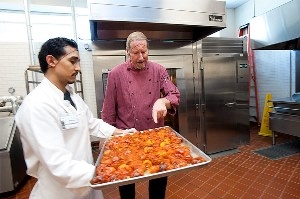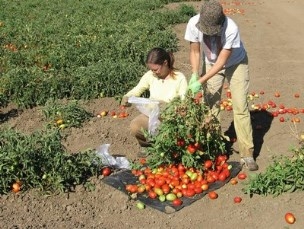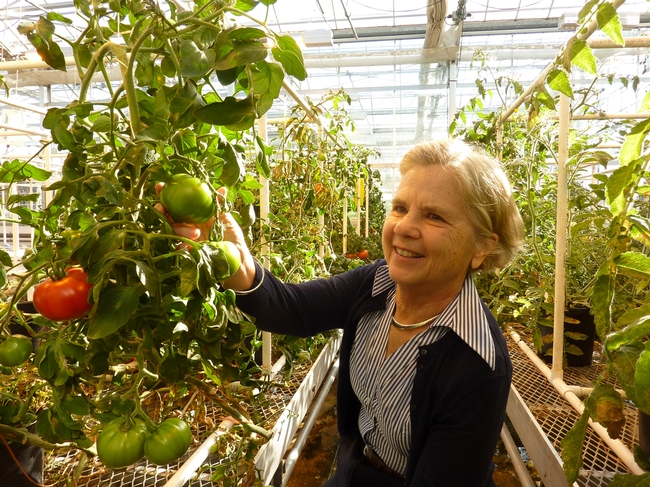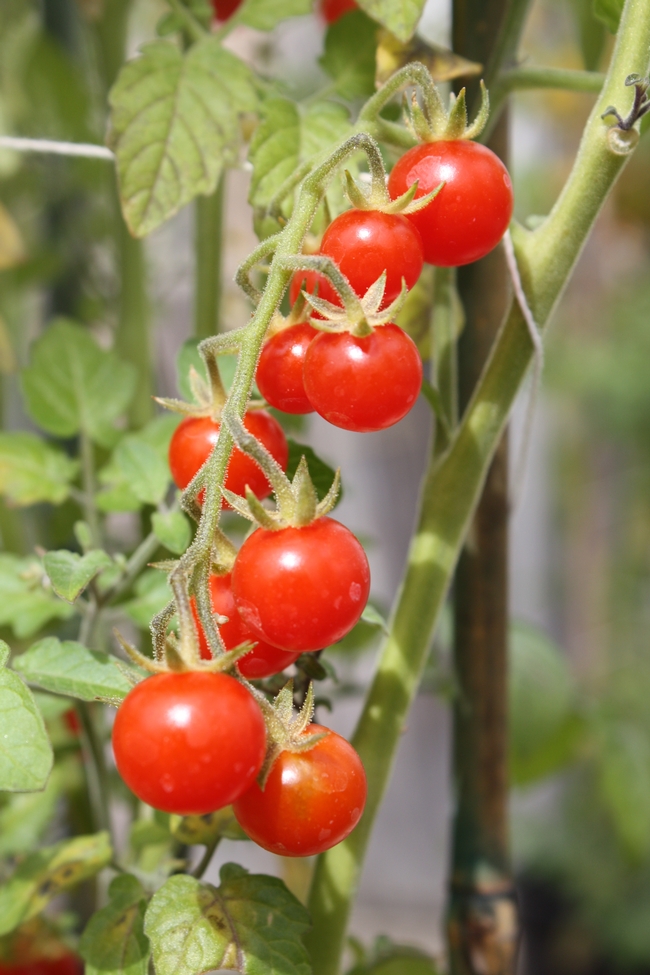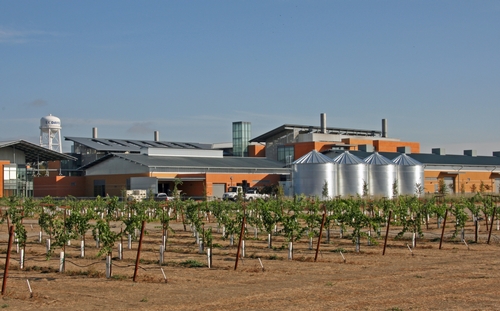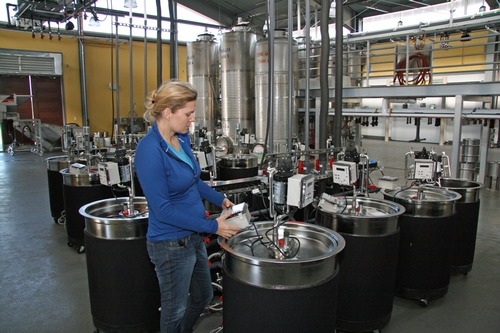Posts Tagged: tomato
UC Davis tomatoes provide year-round healthful eating for college students
At the same time, chefs and food buyers at universities, particularly the University of California, are selecting for high-quality fruits and vegetables, produced locally and sustainably. Universities with strong food sustainability programs are rightfully proud of what they're doing to educate students about food production, health, and nutrition. UC Davis Dining Services prioritizes the purchase of locally grown food (ideally within a 50-mile radius of campus). Most University of California campuses have similar programs.
At UC Davis, fresh roma tomatoes are picked each August from the 300-acre Russell Ranch, part of the campus's Agricultural Sustainability Institute, then processed within hours by campus Dining Services to provide year-round tomato sauce for pizza, pasta, and ratatouille. All told, 10,000 pounds of tomatoes are processed during a two-week period in August. About 29 percent of the total food served in the campus's residential dining halls is from local, organic or sustainable sources.
The tomatoes grown at Russell Ranch are part of a long-term academic research project that examines factors such as farming methods, irrigation needs, crop rotations, yield, and nutritional content. At the end of the growing season, some of the many tons of tomatoes are purchased by Dining Services at market value.
Emma Torbert, an academic coordinator at the UC Davis Agricultural Sustainability Institute, noted, “Connecting the food system to the research is really interesting. A lot of times there is confusion about where our food is coming from. The more people are educated, the more educated decisions they can make.”
Many UC Davis faculty and staff are so impressed with the food choices at the dorms that they purchase individual meal tickets and enjoy lunches made with the campus-grown tomatoes, herbs, and other vegetables, all of which are part of the daily food array. Public dinners are also offered periodically at the dorms so that community members can sit amongst students to taste and learn about the sustainability programs in the dorms.
Additional Information:
- Video: Farm to Table, UC Davis Tomatoes; 2010
- Slide show of this year's UC Davis tomato harvesting and processing system; 2014
- Sustainable Foodservice Progress Report 2014, UC Davis Dining Services
- Two videos of UC Davis students who work at the Student Farm to produce food, including one on tomato sauce production
- “Tomatoes: Safe methods to store, preserve, and enjoy.” UC Agriculture and Natural Resources, free publication
Discovery could deliver vintage flavor to a tomato near you
People often complain about grocery store tomatoes, saying they’re too hard and don’t have the flavor we remember from the days of old. And we thought we knew why - because the millions of tons of tomatoes harvested in the United States and beyond have to be picked before they’re fully ripe and juicy in order to survive being shipped long distances. What’s more, many shoppers store their tomatoes in the fridge, which destroys both their flavor and texture.
But guess what? It’s not just how tomatoes are grown, harvested and stored that affect their flavor. A research team led by Ann Powell, a biochemist in the UC Davis Department of Plant Sciences, has discovered a gene mutation that diminishes a tomato’s flavor even if the fruit is picked ripe and stored well. The finding, which was reported in the June 29 issue of the journal Science, identifies a gene that was unknowingly bred out of modern cultivated tomatoes and plays a vital role in producing the sugars and aromas that make heirloom tomatoes so tasty.
The news is unexpected and encouraging, because now breeders have the genetic information they need to create modern varieties suited for large-scale harvest and shipping with all the flavor of more delicate heirloom varieties.
“Now that we know that some of the qualities that people value in heirloom tomatoes can be made available in other types of tomatoes, farmers can have access to more varieties of tomatoes that produce well and also have desirable color and flavor traits,” Powell said.
It takes awhile to breed a new tomato variety, so don’t expect to taste the results anytime soon. But Powell and her team’s discovery is a huge first step. Tomato lovers can also be grateful for C.M. Rick Tomato Genetics Resource Center at UC Davis, home to a vast collection of mutant and wild species of tomatoes which provides the genetic diversity scientists and breeders need to recapture the flavor of old.
You can read more about the study here.
You can access the Science article here.
You can learn more about the C.M. Rick Tomato Resource Center here.
Survey identifies 19 produce candidates for a farm-to-WIC program
A new federal voucher that gives low-income women access to a range of fruits and vegetables could provide unique new marketing opportunities for California growers.
In 2009, the federal Special Supplemental Nutrition Program for Women, Infants and Children (WIC) began distributing monthly cash vouchers to low-income women with children to buy fruits and vegetables. The program reaches almost half of the infants and one-quarter of children under 5 years old in the United States.
A team of UC Cooperative Extension (UCCE) researchers and nutrition advisors has been exploring the possibility of developing a farm-to-WIC program that would link these low-income consumers with local growers. The purpose of such a program would be to increase the consumption of a wide variety of fresh produce, with a focus on locally grown produce when available.
UCCE conducted a survey of produce preferences and buying habits among WIC participants in Tulare, Alameda and Riverside counties in 2010. The full study is published in the January-March 2012 issue of California Agriculture journal.
Based on the results, the UCCE team developed a list of 19 produce items to promote in a possible new farm-to-WIC program. They are:
|
|
|
Although mustard greens and collards were not popular across all sites, the advisors gauged a potential market in Alameda County, so these were retained. Based on write-in responses, oranges were also added.
In California, which has the nation's largest WIC program, 82 local agencies serve about 1.43 million participants at 623 local centers, and WIC participants can redeem their monthly vouchers at 4,000 grocery stores statewide. About 40 percent shop at WIC-only stores, which stock and sell only WIC-authorized foods.
Stocking produce is relatively new to WIC-only stores; before rollout of new WIC food packages in October 2009, these stores were only required to stock limited amounts of fresh carrots. In the survey, most WIC participants (58 percent to 72.3 percent) responded that their preferred stores offered many choices, but fewer participants (18.5 percent to 41 percent) rated the produce quality as “excellent.” Key factors determining purchase decisions were produce quality and freshness, and nutrient value (vitamins and minerals). Cost was relatively less important, possibly because WIC participants procure the produce with the vouchers.
The list has served as a starting point for discussions with growers and WIC vendors.
“The survey showed that WIC participants were interested in purchasing fresh produce with better quality and more variety,” wrote lead author Lucia L. Kaiser, Cooperative Extension specialist in the UC Davis Department of Nutrition, and co-authors, in California Agriculture. “Some WIC participants that we surveyed said they avoided shopping at WIC-only stores in part because these interests were not met.”
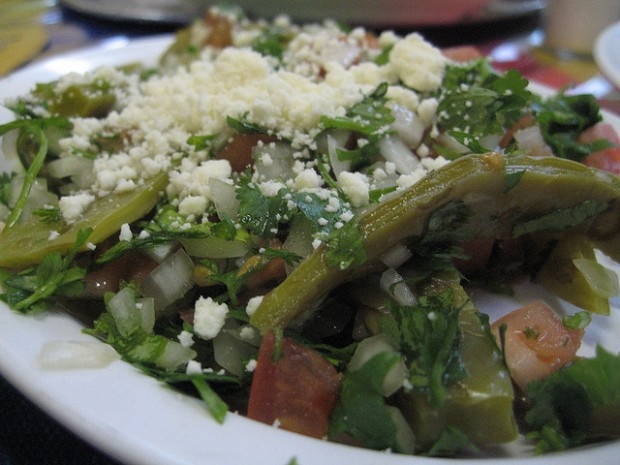
A dish made with nopales (cactus pads).
I say tomato!
Here we are, a month into summer, and one of my favorite fruits is starting to emerge: Luscious tomatoes, fresh off the vine.
I know, most of us treat tomatoes like a vegetable in the kitchen, slicing and dicing them into dishes that are savory rather than sweet. Botanically speaking, tomato is a fruit because it’s developed from the ovary in the base of the flowers and contains the seeds of the plant (though cultivated forms may be seedless.)
No matter, the tomato is a nutritional powerhouse any way you cut it, loaded with vitamin C, vitamin A, potassium and lycopene, an antioxidant credited with preventing both cancer and heart disease.
The UC Davis Department of Plant Sciences devotes many resources to tomato production, helping large- and small-scale growers, organic and otherwise, control weeds, manage pests, fight disease and tackle all the other adventures farming can bring. The department is also home to the C.M. Rick Tomato Genetic Resource Center, the largest known collection of tomato seeds in the world. You can’t breed a better tomato without diversity of genetic tissues, and the repository and its abundance of wild species are the sources of resistance to 44 major tomato diseases and at least 20 insect pets – not to mention improved fruit traits like tolerance to saline conditions and drought.
Of course, growing or buying a tomato is only part of the equation. How do you make sure the fruit of your labor is tasty and safe? Here are some helpful hints from the UC Davis Postharvest Technology Center, a handy resource for all your postharvest technology needs:
How to choose: A ripe tomato will be plump, vibrant in color and fairly firm to the touch. You want it to have a little give, but not much. Ageism aside, avoid a tomato with wrinkles.
How to store: Keep tomatoes at room temperature, away from direct sunlight, with the stem scar (the belly button, if you will) facing up to reduce softening and darkening of the fruit. It’s best to eat them within two or three days, though some tomatoes are perfectly fine for about five days. Store tomatoes unwashed and then rinse them under running water before eating.
How to prepare: After rinsing your tomato well, wipe it dry and cut away the stem scar and surrounding area before slicing into it. Don’t wash tomatoes in a sink filled with water (nor use soap or detergent) because tomatoes can absorb contaminated water and soap residue through its stem scar. Cut or chopped tomatoes (and dishes like salsa) should always be covered and refrigerated if not consumed within two hours or preparation. Cut tomatoes will last one or two days in the refrigerator.
How to enjoy: Enjoy them every which way! It would be hard pick my favorite tomato recipe, but you can’t go wrong with this fast, fresh salad:
Tomato platter special
Four fresh tomatoes of any color or variety
Two red onions
Two orange, yellow or red bell peppers
A few sprigs of basil
Your favorite vinaigrette
Four ounces Feta cheese
Slice the produce into circles and fan them out on a platter in an attractive, alternating order. If you have fresh cucumbers, they fit nicely in this flower, as well. Drizzle with vinaigrette, crumble on some Feta cheese, give a few grinds of fresh pepper and few shakes of salt and place basil sprigs on top.
Delish.
You can read more tomato tips from the Postharvest Technology Center here and explore many more of their practical publications here.
A new era begins in food and beverage science
A new winery, brewery and food-processing complex began operations this fall at UC Davis. Part of the Robert Mondavi Institute for Wine and Food Science, the technologically sophisticated facilities will be used to teach students, conduct research, and solve practical problems related to foods, beverages and health.
The south wing of the new complex is home to the August A. Busch III Brewing and Food Science Laboratory, which includes the brewery, general foods-processing plant and milk-processing laboratory. The complex’s north wing houses a new teaching-and-research winery. The complex is adjacent to a 12-acre teaching-and-research vineyard and across a courtyard from the departments of Food Science and Technology, and Viticulture and Enology.
The new $20 million, 34,000-square-foot complex, funded entirely by private donations, will be the first winery, brewery and/or food-processing facility to earn LEED Platinum certification, the highest environmental rating awarded by the U.S. Green Building Council. (LEED stands for Leadership in Energy and Environmental Design.)
Features include onsite solar power generation and a system for capturing rainwater and conserving processing water. Stored rainwater will be used for landscaping and toilets.
The winery (right) will capture carbon dioxide, a natural byproduct of fermentation, thus reducing the building’s energy requirements for air quality and temperature control.
Other features include maximum use of natural light, food-processing equipment that minimizes energy and water requirements, use of recycled glass in flooring, interior paneling recycled from a 1928 wooden aqueduct, and use of sustainably certified lumber.
The new brewery will showcase the latest in brewing technology, as well as a sophisticated laboratory for conducting research and training students. It also provides commercial brewers and suppliers with a small-scale facility to test new recipes or processes.
The general foods- and milk-processing laboratories have been built to meet state and federal food- and dairy-grade standards. Products processed there will be used in sensory and nutritional evaluations.
Research in the food-processing pilot plant will examine alternative food-processing methods and their nutritional effects, nutritional quality and shelf life of fresh-cut fruits and vegetables, nutritional enhancements from food-processing “waste” products, and improved food formulations.
The milk-processing laboratory will support research on separation of milk components into functional ingredients, processing of milk modified by different feed rations, and processing of milk from cows bred for specific characteristics.
Dozens of private donors helped make the complex a reality, including a $5 million contribution from the late winemaker, Robert Mondavi, and a $5 million pledge by the Anheuser-Busch Foundation.
Other major donations were made by Ronald and Diane Miller and by a group of winery partners led by Jess Jackson and Barbara Banke of Kendall-Jackson Wines, and Jerry Lohr of J. Lohr Vineyards & Wines. The Department of Viticulture and Enology’s Board of Visitors and Fellows also made significant contributions.
California tomato processors and growers contributed more than $2.5 million to the food-processing pilot plant. Morning Star Packing Company provided a lead gift of $1 million for the food-processing plant. Hilmar Cheese Company also stepped up with a $250,000 pledge.
In all, more than 150 individuals, alumni, corporations and foundations contributed funds for the new winery, brewery and food-processing complex.
(Thanks to Patricia Bailey, UC Davis News Service, who provided content for this post.)
Learn more at http://greenrmi.ucdavis.edu.


